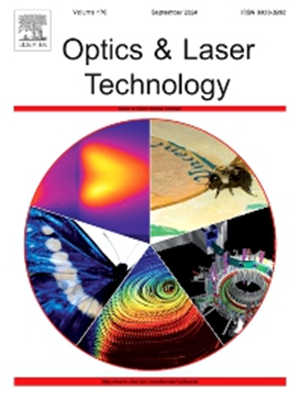Enhancing machining efficiency and precision: Water-jet guided laser fabrication of diamond micro-milling tool
IF 4.6
2区 物理与天体物理
Q1 OPTICS
引用次数: 0
Abstract
The diamond micro-milling tool is a crucial component in micro-milling technology, indispensable for the precise machining of miniaturized parts and structures. However, the manufacturing efficiency of diamond micro-milling tools is challenging due to its extreme mechanical property and micro-sized feature. In this study, Water-Jet Guided laser (WJGL) technology was explored to prepare single-crystal diamond micro-milling tool, aiming to achieve industrial-grade processing efficiency. Both energy-related parameters (laser power and scanning speed) and fluid-related parameters (water flow and shield gas) were investigated to identify the optimal conditions for superior machining quality and material removal rate (MRR). Through cutting through experiments, it was observed that medium laser energy density was most effective in enhancing surface morphology, while high energy led to excessive ablation and low energy resulted in insufficient material removal ability. Moreover, water flow and shield gas affected the kinetic energy of water jet, which reacted on the water stability and subsequent machining quality. MRR was measured and calculated via surface grooving experiments, with ablation ability being the dominant factor. The optimal parameter combination was P = 16 W, v = 6 mm/s, water pressure = 300 bar, and gas flow rate = 1.5 NL/min, achieving the surface roughness Sa/Sz = 149.9 nm/1.503 μ m and MRR of 22.976 × 10-3 mm3/s. A single-crystal diamond micro-milling tool was finally well-prepared within 2 min, with higher machining precision and efficiency compared to conventional methods, highlighting the potential of WJGL for mass production of high-quality diamond micro-milling tools.
提高加工效率和精度:水刀引导激光制造金刚石微铣削工具
金刚石微铣削工具是微铣削技术的重要组成部分,是精确加工微型零件和结构不可或缺的工具。然而,由于金刚石微铣刀具有极高的机械性能和微小尺寸特征,其制造效率面临挑战。本研究采用喷水导引激光(WJGL)技术制备单晶金刚石微铣削工具,旨在实现工业级的加工效率。研究了与能量相关的参数(激光功率和扫描速度)和与流体相关的参数(水流和保护气体),以确定获得优异加工质量和材料去除率(MRR)的最佳条件。通过切削实验观察到,中等激光能量密度对改善表面形态最有效,而高能量则会导致过度烧蚀,低能量则会导致材料去除能力不足。此外,水流和保护气体会影响水射流的动能,从而影响水的稳定性和后续加工质量。通过表面开槽实验测量和计算了 MRR,烧蚀能力是主要因素。最佳参数组合为 P = 16 W,v = 6 mm/s,水压 = 300 bar,气体流速 = 1.5 NL/min,表面粗糙度 Sa/Sz = 149.9 nm/1.503 μ m,MRR 为 22.976 × 10-3 mm3/s。最终在 2 分钟内制备好了单晶金刚石微铣削工具,与传统方法相比,加工精度和效率更高,突出了 WJGL 大规模生产高质量金刚石微铣削工具的潜力。
本文章由计算机程序翻译,如有差异,请以英文原文为准。
求助全文
约1分钟内获得全文
求助全文
来源期刊
CiteScore
8.50
自引率
10.00%
发文量
1060
审稿时长
3.4 months
期刊介绍:
Optics & Laser Technology aims to provide a vehicle for the publication of a broad range of high quality research and review papers in those fields of scientific and engineering research appertaining to the development and application of the technology of optics and lasers. Papers describing original work in these areas are submitted to rigorous refereeing prior to acceptance for publication.
The scope of Optics & Laser Technology encompasses, but is not restricted to, the following areas:
•development in all types of lasers
•developments in optoelectronic devices and photonics
•developments in new photonics and optical concepts
•developments in conventional optics, optical instruments and components
•techniques of optical metrology, including interferometry and optical fibre sensors
•LIDAR and other non-contact optical measurement techniques, including optical methods in heat and fluid flow
•applications of lasers to materials processing, optical NDT display (including holography) and optical communication
•research and development in the field of laser safety including studies of hazards resulting from the applications of lasers (laser safety, hazards of laser fume)
•developments in optical computing and optical information processing
•developments in new optical materials
•developments in new optical characterization methods and techniques
•developments in quantum optics
•developments in light assisted micro and nanofabrication methods and techniques
•developments in nanophotonics and biophotonics
•developments in imaging processing and systems

 求助内容:
求助内容: 应助结果提醒方式:
应助结果提醒方式:


